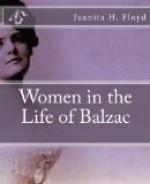Catherine, princess Radziwill.
Author’snote
The steady rise of Balzac’s reputation during the last few decades has been such that almost each year new studies have appeared about him. While the women portrayed in the Comedie humaine are often commented upon, no recent work dealing in detail with the novelist’s intimate association with women and which might lead to identifying the possible sources of his feminine characters in real life has been published.
The present study does not undertake to establish the origin of all the characters found in the Comedie humaine, but is an attempt to trace the life of the novelist on the side of his relations with various women,—a story which is even more thrilling than those presented in many of his novels,—in the hope that it will help explain some of the interesting enigmas presented by his work. So far as the writer could find the necessary evidence, many of the women in Balzac’s novels have been here identified with women he knew in the course of his life; and while giving due weight to the suggestions of various writers, and indicating some of the most striking resemblances, she has tried to avoid a mere promiscuous identification of characters.
In the case of many novelists such an investigation would not be worth while, but Balzac’s place in literature is so transcendent and his life and writings are so closely and fascinatingly interblended, that it is hoped that the following study, in which the writer has striven to maintain correctness of detail, may not be unwelcome, and that it will throw light on Balzac’s complex character, and help his readers better to understand and appreciate some of his most noted women characters. It is believed that this study will show that the influence of women on Balzac was much wider and his acquaintance with them much broader than has previously been supposed.
Apropos of remarks made by Sainte-Beuve and Brunetiere regarding Balzac’s admission to the higher circles of society, Emile Faguet has this to say:
“I would point out that the duchesses and viscountesses at the end of the Restoration were known neither to Sainte-Beuve nor to Balzac, the former only having begun to frequent aristocratic drawing-rooms in 1840, and Balzac, in spite of his very short liaison with Madame de Castries, having become a regular attendant only a few months before that date. Sainte-Beuve himself has told us that the Faubourg Saint-Germain was closed to men of letters before 1830, and since it had to spend a few years becoming accustomed to their admittance, Sainte-Beuve’s testimony is not at all valid as regards the great ladies of the Restoration, even at the end.”
Perhaps it is due partly to the above statement and partly to the fact that Balzac tried to give the impression that he led a sort of monastic life, that it is generally




